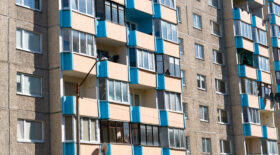The most important aspect for both private and commercial real estate is regular real estate management that helps prevent any issues. However, only people who have faced serious consequences are prone to take prevention seriously. According to Ville Paltsep, Head of Technology of Forus Haldus, very few learn from the mistakes of others.

As buildings have become very modern and smart, comparing their maintenance with that of cars is increasingly appropriate – to make sure that everything works and the users are safe and comfortable, the system must be approached as an integrated entity and the key to averting costly issues is prevention, be it regular inspection of equipment or necessary investments.
In the case of the technical maintenance of a building, its exterior is assessed first – structures must be strong, weatherproof, and show no signs of damage. People often forget that the external structures of a building are particularly vulnerable to the elements. For example, if the top layer of a roof has minor damage that allows water and moisture to seep in, the problem might be undetectable at first, but years later, the water damage is much more extensive and repairs several times more costly.
Inside a building, equipment that needs power, gas, district heating or cooling systems to function must be inspected as it might be dangerous for people, assets, and the surrounding environment if used incorrectly. In other words, making sure that all systems work as intended is the most important aspect here.
Unfortunately, the importance of the preventive maintenance of buildings is still not clear to many today. The prevailing attitude is that if a device works, there is no problem. As soon as a device fails, you face having to deal with consequences. Those who have personally experienced how costly it is to get an unmaintained device working again do not need to be told about the importance of preventive maintenance.
Just like cars, which notify in good time of the need for maintenance or inspection (such as an oil change), buildings tell us of their need for inspection and maintenance. The use of a building management system (BMS) is common, allowing building managers to keep an eye on various systems and to analyse how well they function. This way, it is possible to evaluate the condition of the devices in a building and to prevent failures in the operation of the systems.
For example, a building can notify users when the level of CO2 is too high, air filters are dirty, and the ventilation of the building is no longer compliant with the norms or if energy consumption has increased suddenly. A good example of this are ventilation devices with heat recovery, which are installed in many homes. A device can be connected to the remote monitoring system of the maintenance provider of the device through the internet. The system informs the maintenance provider when the time for replacing air filters is approaching.
However, remote monitoring systems are currently not very common, which is why our experts often come across situations upon arriving on site where the maintenance of devices has only become a priority after a problem has occurred or the damage is so extensive due to ignoring problems in the past that the device needs repairs, or at worst, it must be replaced. This would mean significantly larger costs for the owner of the device than, for example, replacing air filters regularly.
Fortunately, commercial real estate fares better – buildings are larger, more complex, and as a rule, the main activity of the owner of the building is not focused on the maintenance of the building, and therefore, they trust professionals to take care of the building.
Three tips on how to take care of buildings as well as possible
- Think about the use of the building
This might seem pretty basic, but many issues start with neglecting to analyse your building. What type of building is it? For what kind of tenants was the building constructed? What is the purpose of the building? If you ask experts these questions, you can find solutions to make sure that the building can be used for its intended purpose. Well-designed solutions definitely help with convenience and sustainability as well as make sure that the value of the building keeps increasing.
- Ask the building manager how to make the technical building systems work for you
Once the experts have mapped the purpose of a building and inspected its systems, the next step involves the optimisation of its systems. For example, an office building is commonly used from 9 a.m. to 5 p.m., which means that the systems can be configured to work at a lower capacity outside these hours. This, in turn, would help save on the costs of electricity. At the same time, you must be prepared in case someone would like to use the building outside working hours, so you can ensure comfortable indoor climate at that time as well.
- Smart buildings and prevention
To take care of a building as well as possible and to prevent and identify any issues, experts use digital maintenance plans and monitoring measures that they discuss with the client. This way, both parties know exactly which systems are used in the building and what kind of preventive maintenance is provided for the devices. In addition, automated systems are also monitored, and experts can determine the most energy-efficient solutions for a building. Here, you should keep in mind that the more modern a building, the more specific the skill set needed for its maintenance. Complex systems must be monitored as a whole in cooperation with other specialists of their respective fields.
We are the largest maintenance company in Estonia. We provide all essential services. The list of our services is available here.


